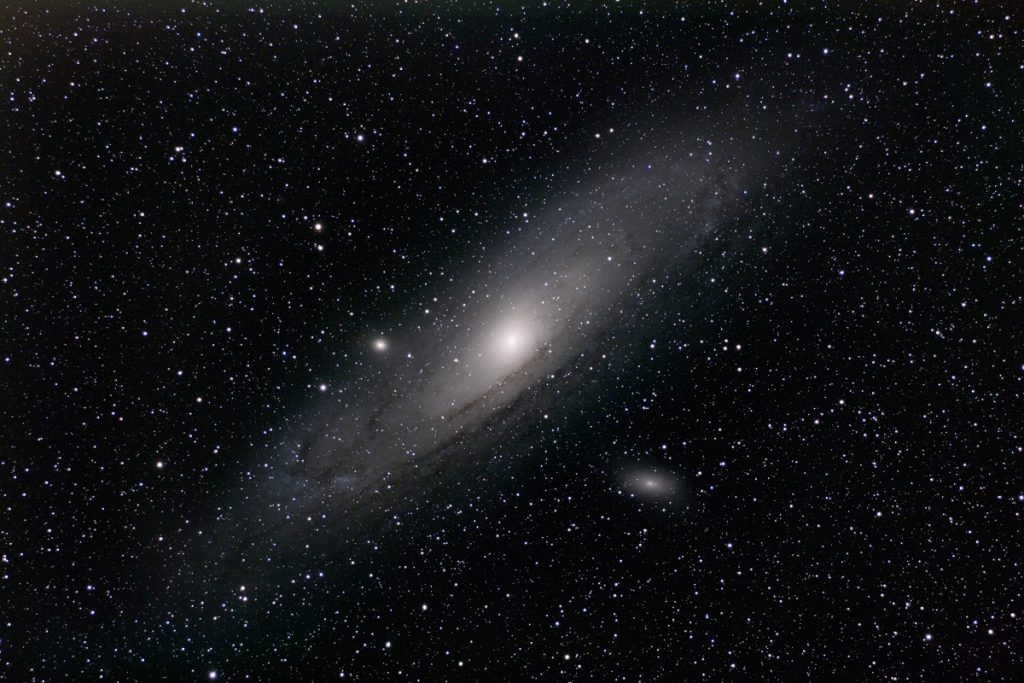Things may seem quiet and peaceful in the Andromeda Galaxy when you gaze at it in the sky. However, if you know what to look for, there’s evidence of a violent rumble in this galaxy’s past. That’s the takeaway from research by Ivanna Escala, an astronomer at Carnegie Institution for Science in Pasadena.
She found telltale clues for a merger a few billion years ago. That’s when Andromeda actively cannibalized another galaxy. Collisions between galaxies create tidal artifacts with all sorts of shapes.
This new work from Ivanna Escala found conclusive evidence that Andromeda’s Northeast, West, and Southeast shelfs and Giant Stellar Stream are the result of a collision with another galaxy. Studying these tidal features can teach us about how galaxies grow and evolve over time as they accrete new material. This composite image of 12 galaxy mergers is courtesy of NASA, ESA, the Hubble Heritage Team (STScI/AURA)-ESA/Hubble Collaboration, and A.
Evans (University of Virginia, Charlottesville/NRAO/Stony Brook University), K. Noll (STScI), and J. Westphal (Caltech).
Mergers Make Galaxies When galaxies collide (and wouldn’t that be a great movie title?), they basically gobble up material from whatever is around—the galaxies themselves, globular clusters, nebulae, whatever’s in the way. They also shove material around rather violently at times. That produces profound disturbances in the wake of the collision.
If you look at the sites of galaxy clashes, you can find knots of star birth, for example. They boil up as material is compressed and shocked by the forces of the collision into active star formation regions. Collisional Pileups It also creates stellar associations called tidal features.
They can look like streams or arcing shells of stars moving along in the wake of the collision. Sometimes they create “pileups” that look like ripples (or arcs of ripples) similar to when you toss a rock into a pond. If you know how to interpret those clues, you can figure out something about the collisions that caused them.
That’s what Escala and her team did. “The remnants of each crash can be identified by studying the movement of the stars and their chemical compositions,” she explained. “Together this information serves as a kind of fingerprint that identifies stars that joined a galaxy in a collision.
” Diving into Andromeda’s Past The Andromeda Galaxy is about 10 billion years old. By comparison, the Milky Way Galaxy is about 13. 6 billion years old.
Like most other galaxies, Andromeda grew by multiple collisions with smaller protogalaxies and subsequent mergers with larger ones. The Milky Way is currently gobbling up at least one dwarf galaxy and also formed by mergers. The trick to figuring out the merger history is, as any crime scene detective knows, buried in the details.
Astronomers look at the chemical components of stars and figure out which are native to the galaxy and which are not. Stellar motions can reveal intruders. If the merger is particularly violent, streams of stars and gas and dust will form observable features.
Digging Into Andromeda’s Stars Escala and her collaborators looked deep into Andromeda at a feature called the Northeast Shelf. They analyzed 556 red giant branch stars within it. “We performed the first detailed characterization of the chemical composition and geometric motion of the stars in this region of our neighboring galaxy, demonstrating conclusively that the NE shelf is a tidal shell predominately composed of debris from the aftermath of a collision,” Escala explained during a press conference at the American Astronomical Society Meeting in Pasadena, CA.
This image shows NASA/ESA Hubble Space Telescope images of a small part of the giant stellar stream of the Andromeda Galaxy. The stream is a long structure thought to be the remains of a companion galaxy torn apart by the Andromeda Galaxy’s gravity and engulfed in it. By studying details of the stars in the stream, astronomers can determine the chemistry and ages of the stars in each part of the Andromeda Galaxy.
They also showed that this ledge is part of a multi-shell system, along with the galaxy’s west and southeast shelves. The material in these regions is consistent with that of Andromeda’s Giant Stellar Stream, created during the recent large collisions. It’s likely that all those tidal features could have come from the same source.
“Our results are in line with modeling that predicted the Giant Stellar Stream is the first loop of material from a collision and the NE shelf is the second layer wrap-around,” Escala concluded. The wrap-around she mentions points toward multiple encounters during the collision/cannibalization event. Gravitational interactions at the time shaped the streams.
The analysis done by Escala and her team is an important step toward confirming predictions about this galaxy’s violent past. Collisions are an important part of that history. More evidence about these actions gives a deeper understanding of the many features left behind long after the merger ends.
For More Information Tracing The Remnants Of Andromeda’s Violent History The post Andromeda Tore Apart and Consumed a Neighbor Galaxy appeared first on Universe Today. .
From: universetoday
URL: https://www.universetoday.com/156320/andromeda-tore-apart-and-consumed-a-neighbor-galaxy/



